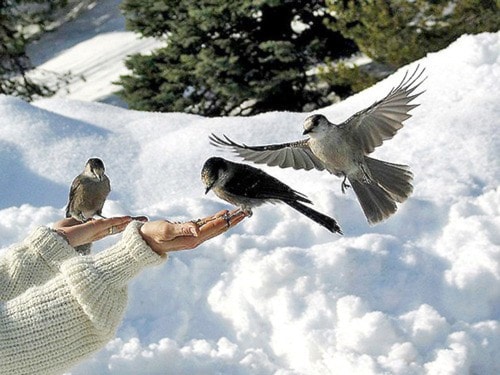Yes, the gray jay (Perisoreus canadensis) should be Canada’s national bird – but its name should be changed back to whisky-jack or, if you like, whisky jay.
One of the great pleasures in much of Canada’s backcountry, especially in winter, is to experience gray jays feeding from your hand.
If there is any way to feel a real connection with nature and with Canada’s history, this is it.
It is easy to imagine the birds visiting a First Nations camp thousands of years ago doing exactly the same things – looking for a handout and checking up on what is going on.
Gray jays are highly intelligent, social, and utterly fearless (perhaps too much so, in some cases).
They are found throughout Canada, except on the Prairies, in the far North, and close to civilization.
According to Wikipedia, they can live for up to 16 years in the wild.
They form monogamous mating pairs, with the pairs often accompanied by a juvenile from the previous year.
Related to crows and ravens, gray jays have a brain-to-body size ratio that is similar to chimpanzees and dolphins – and close to that of humans.
They need those big brains because they survive the winter using cached food they stored in summer – and they have to remember where they hid it.
Caching food means they need cold temperatures to ensure successful storage of perishables. That could mean they will face difficulties as climate change shifts their habitat northwards.
An online poll and expert panel organized by Canadian Geographic Society last year chose the gray jay as the best candidate to be Canada’s national bird. It beat out the snowy owl, black-capped chickadee, Canada goose and common loon. The choice is expected to become official sometime this year.
It’s a good choice but we’ve got to do something about the name. “Gray jay” sounds as if it was chosen by a committee of ornithologists (which it was). The birds are known by multiple common names, including gray jay, Canada jay, and camp robber but my favorite is whisky-jack.
Whisky-jack is an Anglicized form of Wisakedjak, which is an Algonquian and Dene mythological figure or trickster god. The Cree see him as a benign spirit; fun-loving, cheerful, and an example of good manners and good company.
The name whisky-jack has been criticized because it does not adequately describe the bird as a jay. If that is a problem, then why not whisky jay?
Whether it is called gray jay, whisky-jack or simply Perisoreus canadensis, the bird is a true symbol of the Canadian wilderness and our shared history. Officially naming it as Canada’s national bird would remind us of the importance of that wilderness and that history.

